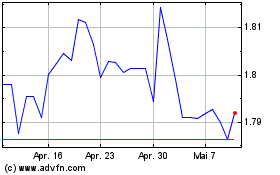Commodity Currency's Slide As Crude Oil Prices Traded Lower
21 Januar 2025 - 4:26AM
RTTF2
The commodity currencies such as Australia, the New Zealand and
the Canadian dollars weakened against their major currencies in the
Asian session on Tuesday, as oil prices dropped after the U.S.
President Donald Trump postponed imposing fresh tariffs and
unveiled a plan to increase U.S. oil and gas production.
The West Texas Intermediate Crude oil futures for March dropped
67 cents to $76.72 per barrel.
Brent crude futures fell 11 cents, or 0.14 percent, to $80.04
per barrel.
Oil prices fell as a result of President Donald Trump's
announcement of a plan to increase U.S. oil and gas output and his
suggestion to impose 25% tariffs on imports from Canada and Mexico
starting on February 1 rather than immediately.
Meanwhile, the markets reacted positively to U.S. President
Donald Trump's decision not to impose China-specific tariffs on his
first day in office.
Markets were bracing for major policy announcements and sweeping
changes in U.S. trade policies that could thrust businesses into
considerable uncertainty.
Trump also stated, "If we make a TikTok deal and China doesn't
approve it, we could maybe put tariffs on China." He made this
statement following his signing of an executive order postponing
the implementation of the TikTok ban by seventy-five days.
In economic news, data from Business NZ showed that the New
Zealand Performance of Service Index (PSI) fell to 47.9 in December
from 49.5 in November, extending its contraction streak to ten
consecutive months.
In the Asian trading today, the Australian dollar fell to an
8-day low of 1.6681 against the euro and a 6-day low of 1.1039
against the NZ dollar, from yesterday's closing quotes of 1.6593
and 1.1055, respectively. If the aussie extends its downtrend, it
is likely to find support around 1.68 against the euro and 1.08
against the kiwi.
The aussie edged down to 0.6209 against the U.S. dollar, from an
early more than a 2-week high of 0.6289. The aussie may test
support near the 0.60 region.
Against the yen, the aussie edged down to 96.83 from Monday's
closing value of 97.52. On the downside, 94.00 is seen as the next
support level for the aussie.
The NZ dollar fell to 0.5622 against the U.S. dollar, from an
early 2-week high of 0.5689. The next downside target for the kiwi
is seen around the 0.54 region.
Against the yen and the euro, the kiwi edged down to 87.60 and
1.8421 from yesterday's closing quotes of 88.21 and 1.8343,
respectively. If the kiwi extends its downtrend, it is likely to
find support around 86.00 against the yen and 1.86 against the
euro.
The Canadian dollar fell to nearly a 5-year low of 1.4518
against the U.S. dollar and nearly a 4-week low of 1.5051 against
the euro, from Monday's closing quotes of 1.4303 and 1.4905,
respectively. If the loonie extends its downtrend, it is likely to
find support around 1.46 against the greenback and 1.52 against the
euro.
Against the yen and the Australian dollar, the loonie dropped to
more than 1-month lows of 107.34 and 0.9034 from yesterday's
closing quotes of 108.57 and 0.8983, respectively. The loonie may
test support near 104.00 against the yen and 0.92 against the
aussie.
Looking ahead, Germany's ZEW economic confidence survey results
for January are due at 5:00 am ET in the European session. The
economic sentiment index is expected to fall to 15.2 in January
from 15.7 in December.
In the New York session, Canada CPI reports for December are
slated for release.
Euro vs NZD (FX:EURNZD)
Forex Chart
Von Dez 2024 bis Jan 2025

Euro vs NZD (FX:EURNZD)
Forex Chart
Von Jan 2024 bis Jan 2025
